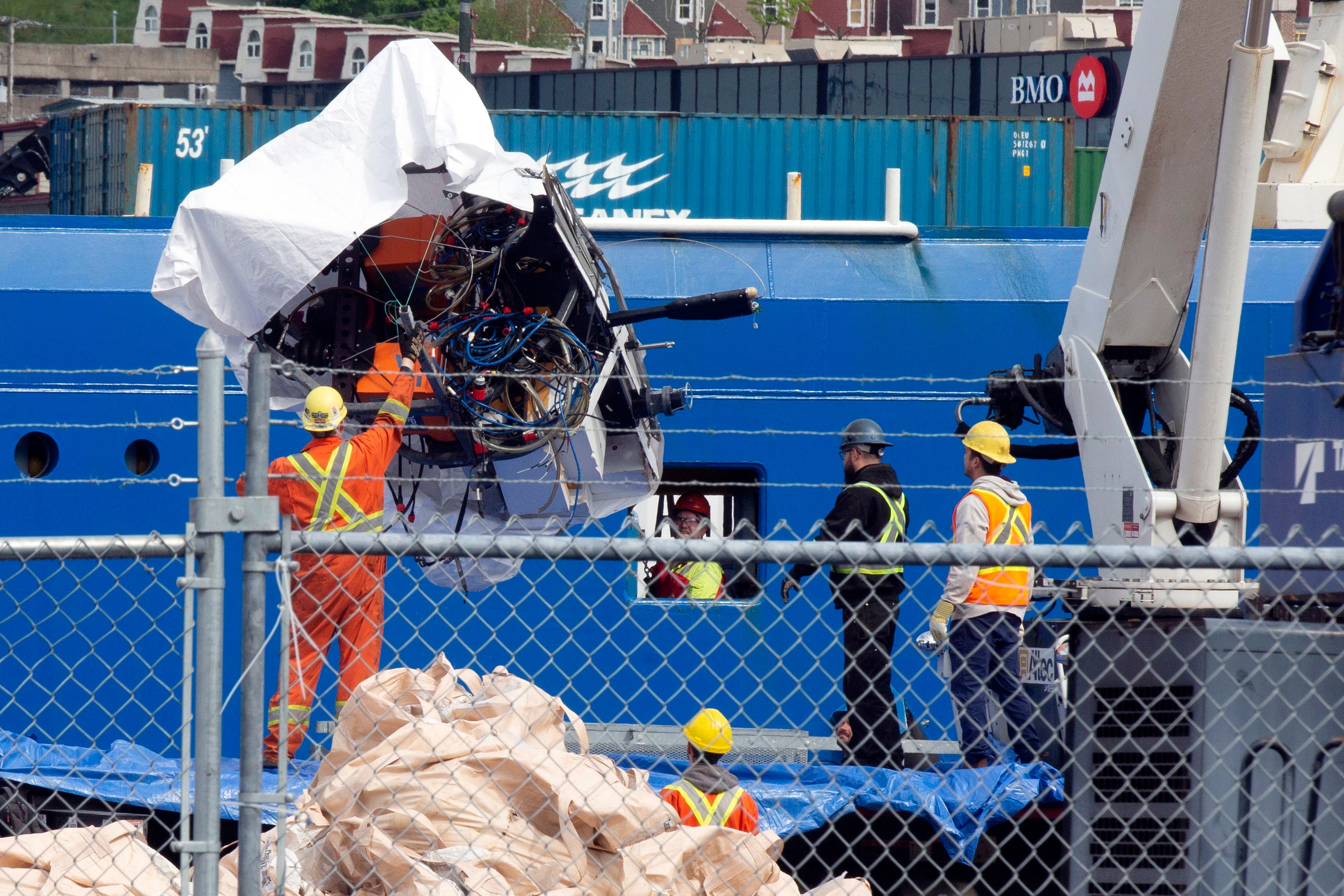What photos of the Titanic sub debris tell us about its implosion
‘Although it seems counterintuitive, large objects do not normally split apart into smithereens in an implosion or explosion’
Images of the wreckage recovered from the Titan submersible at the bottom of the North Atlantic appear to confirm the theory that the vessel suffered a massive implosion under the pressure of the ocean.
Earlier this week, the US Coast Guard brought the debris left by the sub on the ocean floor onto dry land.
Jonas Mureika, a professor of physics at Loyola Marymount University, tells The Independent that calling the implosion “catastrophic” is referring to the intensity and speed of what took place.
“The pressure at that depth (3.8 km) is incredibly high, about 400 times atmospheric pressure. That’s 6,000 pounds per square inch acting on the submarine – atmospheric pressure is roughly 15 pounds per square inch,” he noted in an email.

“If the hull integrity was compromised or weakened in one spot, the inward pressure would quickly cause it to buckle asymmetrically, and the structure would implode because of the inward force. And at those pressures, the inward collapse would have occurred in milliseconds,” he adds. But this doesn’t mean the debris itself would be crushed in size, just that the pressure was inward.”
Dr Joerg Reinhold, a professor at the Department of Physics at Florida International University, added that “it seems the pressure vessel of the submersible consisted of a cylindrical hull capped off by two at least somewhat spherical endcaps or domes. One of these includes a viewport. In pictures, it seems the other dome is covered by another shell in the shape of a fin or so”.


“The cylindrical hull seems surrounded by a shell of the same material ... I would expect that these shells do not add to the structural integrity of the hull. That means all the forces from the surrounding water act on the hull inside these shells,” he said. “I actually expect that the space between the shells and the hull is exposed to water at the same pressure as the surrounding water. It is therefore conceivable that these shells survive in larger pieces.”
Dr Reinhold noted that at least one of the domes from the vessel appears to have been found intact.
“My understanding is that these are made from titanium and not the carbon fibre material used for the cylindrical hull. Given the spherical shape and the material, I am not surprised that they, or at least one of them, stayed mostly intact,” he said.

Arun Bansil, a professor at the physics department at Northeastern University in Boston, told The Independent that “although it seems counterintuitive, large objects do not normally split apart into smithereens in an implosion or explosion”.
“For example, a pressure cooker usually explodes with the top blown off but the body remaining intact. Initial failure of Titan would have occurred at its weakest links such as defects in the hull. Once a crack opens, however, large pieces of the hull will no longer experience very violent forces and remain more or less intact,” he said.


Was it an explosion or implosion and how would that have affected the passengers?
“Knowing where the accident occurred, the assumption of an implosion makes sense,” Dr Reinhold said. “Both an implosion and an explosion need some form of stored energy. In typical explosive materials, the stored energy is chemical and is released through a chemical reaction. In the case of a submerged pressure vessel, the stored energy is mechanical – it is released when the surrounding water fills the space of the vessel.”
“If there is a catastrophic failure of the hull, this energy is first released in an implosion,” he notes. “Eventually, this will be followed by an outgoing shockwave – otherwise, listening devices would not be able to pick up the sound of the event.”
He went on to say that “implosions or explosions in water should behave differently than those in air. Air is a compressible fluid while water is an incompressible fluid. I expect the stored mechanical energy to be vastly bigger than any other source of energy on the submersible”.

“Even if the breach of the vessel would have been triggered by an internal source of energy, the final result will be an implosion,” Dr Reinhold said.
Dr Mureika added that “an explosion results when there is a sudden release of energy that results in a powerful outward pressure wave. Implosions, on the other hand, are due to an inward pressure differential. This was most certainly an implosion”.

“That being said, when the air inside the submarine was rapidly compressed, it most likely ignited and created an explosion – like a piston in a car engine – but this wouldn’t compare in magnitude to the implosive force,” he says.
“As for the passengers, because of the time interval for this to occur, as well as the magnitude of the pressure, it’s very likely they didn’t even know what hit them. It’s also doubtful they had time to process what was happening unless the implosion was preceded by something like a leak,” Dr Mureika adds.
How will the debris be used to determine what happened?
“The obvious would be to look at the recovered pieces as well as design drawings and possibly any samples of the materials that the company might still have,” Dr Reinhold said.
Join our commenting forum
Join thought-provoking conversations, follow other Independent readers and see their replies
Comments


Bookmark popover
Removed from bookmarks